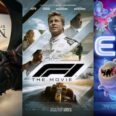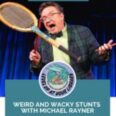ArtCenter College of Design’s Alyce de Roulet Williamson Gallery is currently hosting other-wordly “Uncertainty,” the latest in a series of exhibitions exploring the confluence of science and art and curated by Gallery Director Stephen Nowlin. The indoor setup features nine installations created by artists and scientists in an exhibition that ponders the edges of knowledge and perception, and probes the aesthetics of science data with several pieces on display from Caltech creatives.
“Uncertainty scans the idea that we don’t need to fill in the unknown with fanciful supernatural speculations. It rejects the notion that science is a mechanical and calculated way of relating to existence — that it strips away sensations of transcendence. The exhibition is all about finding the poetic in science and its processes. Accepting uncertainty and provisional knowledge philosophically, as science does in its methodology, is part of that change,” said Nowlin.
Nowlin is a maker/artist and founding director of ArtCenter’s Alyce de Roulet Williamson Gallery. He has initiated multiple curatorial projects at the intersection of science and art, for which he has produced objects, catalogues, brochures, and written essays.
Nowlin received his MFA degree in Fine Art at ArtCenter, and a BFA in Design at CalArts. He is currently co-curating ECLIPSE, a summer 2017 exhibition probing the art, science, and culture of natural phenomena, in association with Williams College (Massachusetts) astronomer Jay Pasachoff and New York Historical Society Curator of Drawings Roberta Olson.
“Uncertainty blurs the boundaries between science and art by showing products and artifacts of the two domains side-by-side with little or no distinction. The net result is perhaps some fruitful speculation about which is which, and why,” said Nowlin.
Participants in “Uncertainty” include San Francisco artist and electrical engineer Jim Campbell, artist and science graphics editor for the New York Times Jonathan Corum, L.A. based artist Marc Fichou, University of Notre Dame physicist and software scientist Thomas McCauley, The Einstein Collective (artist Sara Mast, architect Jessica Jellison, artist and animator Christopher O’Leary, filmmaker Cindy Stillwell, sound artist and composer Jason Bolte, physicist Charles Kankelborg, physicist Nico Yunes, physicist Joey Shapiro Key), and San Francisco artist that works with mathematics and the uncertainties of algorithmic form Owen Shuh.
“It’s important to celebrate quality, serious endeavor, innovation, creativity, weirdness, contradiction, and disruption. That’s what I look for in artists for the gallery shows,” said Nowlin.
Aside from its “frontiers of science and art” emphasis, the show has a number a Caltech connections through included works by Donald A. Glaser (Caltech grad, Nobel Laureate), Richard Feynman (Feynman’s ’75 Dodge van on display, as well as artworks influenced by “Feynman Diagrams”), and Lia Halloran (dual shows at “Uncertainty” and Caltech’s Cahill Center for Astronomy), according to Nowlin.
“In its science and art exhibits, the Williamson Gallery is not trying to be a science museum. It is an art gallery — so the exhibits are meant to be experiential and immersive, not pedagogical. I would rather people walk away a bit confused, than with a handful of facts,” said Nowlin.
The 4600 square-foot Williamson Gallery is nationally and internationally recognized for it series of exhibitions exploring the intersection of science and art. It draws inspiration from all the fertile domains of ArtCenter’s art and design programs, producing three major exhibitions per year, according to Nowlin.
“Its mission is to be an active partner in the education of intelligent and spirited students who will shape visual culture in the future, and to engage the broader public community in a progressive dialogue about art and new ideas for the 21st century,” said Nowlin.
In association with the “Uncertainty” exhibition, the public is invited to a free lecture “The Thinking Eye” by Edward Tufte on Thursday, October 20, at 7 p.m., in the Ahmanson Auditorium located at ArtCenter’s Hillside Campus. A wine reception and viewing of UNCERTAINTY will take place in the Williamson Gallery, following Tufte’s lecture.
Known for his writings on information design, Tufte is a pioneer in the field of data visualization. The New York Times describes him as the “da Vinci of data,” and Business Week calls him the “Galileo of graphics.” His artworks in “Uncertainty” are wall sculptures based on “Feynman Diagrams,” a visual language describing the behavior of subatomic particles invented by Nobel Laureate and Caltech physicist Richard Feynman, according to a press release.
ArtCenter College of Design’s Alyce de Roulet Williamson Gallery is located at 1700 Lida Street in Pasadena. For more information, contact williamson.gallery@artcenter.edu Or call (626) 396-2397.
For links to “Uncertainty”: http://williamsongallery.net/uncertainty
For links to further Williamson Gallery art-science activities: http://williamsongallery.net/google














 0 comments
0 comments


